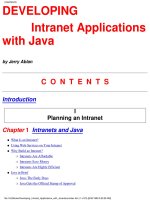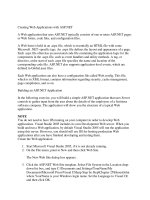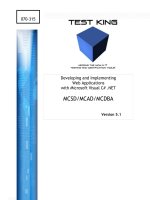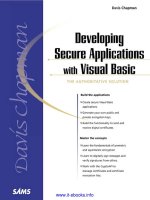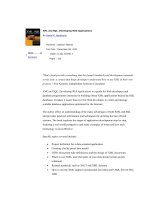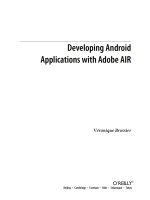Developing web applications with oracle ADF essentials
Bạn đang xem bản rút gọn của tài liệu. Xem và tải ngay bản đầy đủ của tài liệu tại đây (40.85 MB, 270 trang )
www.it-ebooks.info
Developing Web Applications
with Oracle ADF Essentials
Quickly build attractive, user-friendly web applications
using Oracle's free ADF Essentials toolkit
Sten E. Vesterli
professional expertise distilled
P U B L I S H I N G
BIRMINGHAM - MUMBAI
www.it-ebooks.info
Developing Web Applications with
Oracle ADF Essentials
Copyright © 2013 Packt Publishing
All rights reserved. No part of this book may be reproduced, stored in a retrieval
system, or transmitted in any form or by any means, without the prior written
permission of the publisher, except in the case of brief quotations embedded in
critical articles or reviews.
Every effort has been made in the preparation of this book to ensure the accuracy
of the information presented. However, the information contained in this book
is sold without warranty, either express or implied. Neither the author nor Packt
Publishing, and its dealers and distributors will be held liable for any damages
caused or alleged to be caused directly or indirectly by this book.
Packt Publishing has endeavored to provide trademark information about all of the
companies and products mentioned in this book by the appropriate use of capitals.
However, Packt Publishing cannot guarantee the accuracy of this information.
First published: August 2013
Production Reference: 1160813
Published by Packt Publishing Ltd.
Livery Place
35 Livery Street
Birmingham B3 2PB, UK.
ISBN 978-1-78217-068-6
www.packtpub.com
Cover Image by Artie Ng ()
www.it-ebooks.info
Credits
Author
Project Coordinator
Sten E. Vesterli
Apeksha Chitnis
Reviewers
Proofreader
Eugene Fedorenko
Paul Hindle
Amr Gawish
Dimitrios Stasinopoulos
Acquisition Editors
Indexer
Hemangini Bari
Graphics
Erol Staveley
Ronak Dhruv
Antony Lowe
Lead Technical Editor
Madhuja Chaudhari
Production Coordinator
Aditi Gajjar
Cover Work
Technical Editors
Aditi Gajjar
Anita Nayak
Pragati Singh
Vrinda Nitesh Bhosale
www.it-ebooks.info
About the Author
Sten E. Vesterli picked up Oracle development as his first job after graduating
from the Technical University of Denmark, and he hasn't looked back since. He has
worked with almost every development tool and server Oracle has produced in the
last two decades, including Oracle ADF, JDeveloper, WebLogic, SQL Developer,
Oracle Portal, BPEL, Collaboration Suite, Designer, Forms, Reports, and even Oracle
Power Objects.
He started sharing his knowledge with a conference presentation in 1997, and has
since given more than 100 conference presentations at Oracle OpenWorld, ODTUG,
IOUG, UKOUG, DOAG, and other user group conferences around the world. His
presentations are highly rated by the participants, and in 2010, he received the
ODTUG Best Speaker award.
He has also written numerous articles, participated in podcasts, and has written
the books Oracle Web Applications 101, The McGraw-Hill Companies and Oracle ADF
Enterprise Application Development – Made Simple, Packt Publishing. You can find his
blog at www.vesterli.com and follow him on Twitter as @stenvesterli.
Oracle has recognized Sten's skills as an expert communicator on Oracle technology
by awarding him the prestigious title of Oracle ACE Director, which is carried by less
than 100 people in the world. He is also an Oracle Fusion User Experience Advocate
and is a part of the Oracle Usability Advisory Board and participates in the Oracle
WebLogic Partner Council.
Based in Denmark, Sten is a partner in the Oracle consulting company Scott/
Tiger, where he works as a Senior Principal Consultant. When not writing books
or presenting, he is helping customers choose the appropriate technology for their
needs, teaching, mentoring, and leading development projects. In his spare time,
Sten enjoys triathlons, and he completed his first Ironman in 2012.
www.it-ebooks.info
Acknowledgement
As an ADF enthusiast, I'd like to thank Oracle for finally making a free version
of Oracle ADF available. With it's high productivity and advanced features, ADF
Essentials has the potential to become the standard way of writing data-handling
applications. With this book, I hope to help that become a reality.
Others have gone before me in the quest to get the combination of ADF Essentials,
MySQL, and GlassFish to work together. I'd especially like to thank Markus Eisele,
Duncan Mills, Chris Muir, Jobinesh Purushothaman, Bauke Scholtz, and Shay
Shmeltzer, whose work with ADF, Apache Shiro, MySQL, and GlassFish I have
benefited from.
I also appreciate the efforts of the people at Packt Publishing who have been
supporting this project, as well as my reviewers who have improved the book with
their excellent questions and suggestions.
Finally, I'd like to thank my lovely wife for her love, support, and understanding for
yet another book project.
www.it-ebooks.info
About the Reviewers
Eugene Fedorenko is a senior analyst with extensive experience and management
skills. He works for the Ukrainian software company CS Integra. The company
focuses on banking software and is a leader in the local market. The company
has been an Oracle Platinum partner since 2010 and it was rewarded as the Best
Independent Software Vendor in the Eastern Europe region. Eugene graduated from
the Kharkiv Aviation Institute in 1999 with an M.Sc. in Computer Science. He began
his career in the company in 2000 as a developer. Currently, he is a senior analyst
and he is in charge of running projects connected to Oracle Application Development
Framework. He is the author of the ADF practice blog http://adfpractice-fedor.
blogspot.com and a member of the ADF Enterprise Methodology Group.
Amr Gawish is a Senior Oracle Fusion Middleware Consultant. He is a certified
WebCenter Portal and Oracle SOA implementation specialist. He has over five
years of experience with the Oracle Middleware stack. He holds a Bachelor's degree
in Math and Computer Sciences from Al-Azhar University in Egypt, and he has
been involved in many ADF, WebCenter, and SOA projects. He currently works at
infoMENTUM, which is an Oracle Gold Partner and a leading company in Oracle
Fusion Middleware, and it is the first company to be specialized in WebCenter
(both Content and Portal) in the EMEA region. It's what Amr calls "a place where
innovation comes true!"
Amr is also currently authoring a book about ADF Faces called Oracle ADF
Faces Cookbook, Packt Publishing.
I'd like to thank my wife for helping and encouraging me to
complete the review in time, and my daughter for always bringing a
smile to my face.
www.it-ebooks.info
Dimitrios Stasinopoulos is a Certified Application Development Framework
Implementation Specialist with more than six years of experience in Oracle Fusion
Middleware and, more specifically, in ADF BC 11g. Dimitrios currently works as an
Oracle Fusion Middleware Consultant, mainly focusing on Oracle ADF, at e-DBA
Ltd., an Oracle Platinum Partner. Dimitrios has worked in several Oracle ADF
projects in various positions, from developer to architect, and he also enjoys teaching
and talking about Fusion Middleware.
In his spare time, Dimitrios is helping the ADF community by answering technical
questions in the Oracle ADF and JDeveloper forum, and he also maintains a blog
where he posts his findings and ideas: dstas.blogspot.com.
Dimitrios holds a B.Sc. degree in Computer Science from the Technological
Educational Institution of Larissa, Greece.
www.it-ebooks.info
www.PacktPub.com
Support files, eBooks, discount offers and more
You might want to visit www.PacktPub.com for support files and downloads related to
your book.
Did you know that Packt offers eBook versions of every book published, with PDF and ePub
files available? You can upgrade to the eBook version at www.PacktPub.com and as a print
book customer, you are entitled to a discount on the eBook copy. Get in touch with us at
for more details.
At www.PacktPub.com, you can also read a collection of free technical articles, sign up for a
range of free newsletters and receive exclusive discounts and offers on Packt books and eBooks.
TM
Do you need instant solutions to your IT questions? PacktLib is Packt's online digital book
library. Here, you can access, read and search across Packt's entire library of books.
Why Subscribe?
•
Fully searchable across every book published by Packt
•
Copy and paste, print and bookmark content
•
On demand and accessible via web browser
Free Access for Packt account holders
If you have an account with Packt at www.PacktPub.com, you can use this to access
PacktLib today and view nine entirely free books. Simply use your login credentials for
immediate access.
Instant Updates on New Packt Books
Get notified! Find out when new books are published by following @PacktEnterprise on
Twitter, or the Packt Enterprise Facebook page.
www.it-ebooks.info
Table of Contents
Preface1
Chapter 1: My First ADF Essentials Application
9
Getting ready
Installing MySQL
MySQL installation
Configuring
Changing MySQL options
Does it work?
Modifying some data
Installing Java Development Kit and GlassFish
Installing JDK 7
Installing GlassFish
GlassFish installation
Setting up the domain
Does it work?
Installing the MySQL connector in GlassFish
Adding a DataSource to GlassFish
Installing ADF Essentials
Getting ADF Essentials
Installing the ADF Share libraries in GlassFish
Setting the GlassFish JVM parameters
Does it work?
Installing JDeveloper
JDeveloper or Eclipse?
Which JDeveloper?
JDeveloper installation
Installing the MySQL Connector in JDeveloper
Installing the GlassFish Server Extension
Connecting to the GlassFish server
www.it-ebooks.info
10
10
12
14
16
16
18
19
19
21
22
23
24
25
25
27
27
28
29
30
30
30
31
32
32
33
35
Table of Contents
Building a simple ADF Essentials application
36
Creating the application
36
Database38
Business service
38
Model layer
41
Controller layer
42
View layer
42
Getting ready to deploy
43
DataSource
Application module configuration
Change platform
Running your first ADF Essentials application
Can it run faster?
Setting up WebLogic for MySQL
Adding a DataSource to WebLogic
Running your first ADF Essentials application again
Summary
Chapter 2: Creating Business Services
Business service possibilities
ADF Business Components
Starting the example application
How ADF business components work
Building your own foundation
Building framework extension classes
Using framework extension classes
Building entity objects for the example application
Preparing to build
Running the wizard
Examining the result
Setting the labels
Autogenerated values
Cleaning up the data types
Cleaning up the associations
Deleting superfluous associations
Fixing wrong associations
Removing invalid references from entity objects
Building view objects
The storyboard
Building the customer view object
Building the rental view object
Creating a view link
Application module
[ ii ]
www.it-ebooks.info
44
44
44
45
47
47
47
48
48
49
49
50
53
53
56
57
58
59
60
61
62
63
63
64
66
67
68
70
71
71
72
75
78
79
Table of Contents
Testing business components
Summary
Chapter 3: Creating Task Flows and Pages
Building task flows
Bounded and unbounded task flows
Pages and fragments
Task flow templates
Example application
Building the Rent DVD task flow
Building the Return DVD task flow
Memory scopes
Other elements of task flows
Building pages
Using templates
82
83
85
86
86
87
88
89
89
92
97
98
99
99
Facet definitions
Page fragment template
Page template
100
100
102
Example application
106
Building the customer search page
Building the Return DVD page
An alternative – ADF query panel
Building the Rent DVD page
Building a master page
Running the page
Using data bindings
Showing a customer on a page
Showing customer rentals on a page
Adding navigation
Summary
Chapter 4: Adding Business Logic
Adding logic to business components
Logic in entity objects
Overriding accessors
Working with database triggers
Overriding doDML()
106
109
109
109
110
112
113
113
116
120
120
121
121
122
122
124
125
Data validation
127
Logic in view objects
130
Logic in application modules
134
Declarative validation
Regular expression validation
Groovy scripts
Method validation
127
129
130
130
Overriding accessors
Change view criteria
131
132
[ iii ]
www.it-ebooks.info
Table of Contents
Adding logic to the user interface
Adding a bean method to a button
Adding a bean to a task flow
Accessing UI components from beans
Accessing the binding layer
135
135
136
137
138
Showing messages
Example application
Registering a rental
140
141
142
Registering a return
147
Marking items returned today
152
Working with attribute values
Working with operations
Working with whole datasets
Creating a bean
Mapping the fields
Establishing bindings
Writing the code
138
139
140
142
143
144
146
Adding a column and a button
Creating a bean
Mapping the table
Creating a view object method
Publishing your method
Establishing bindings
Writing the bean code
147
148
148
149
150
151
151
Creating a transient attribute
Binding the new attribute
Coding the attribute return value
Using the attribute value
Other ideas
152
153
153
154
155
Summary
Chapter 5: Building Enterprise Applications
Structuring your code
Workspaces and projects
The workspace hierarchy
The directory structure
Using version control
Working with ADF libraries
Creating ADF libraries
Releasing ADF libraries
Using ADF libraries
Example application
Creating the Master Application Workspace
Creating the workspace
[ iv ]
www.it-ebooks.info
155
157
157
158
158
159
160
162
162
163
164
164
165
165
Table of Contents
Adding to source control
Creating the ADF library folder
166
168
Creating the CommonCode workspace
169
Creating the CommonUI workspace
172
Creating the CommonModel workspace
176
Creating the RentDvd subsystem workspace
178
Creating the ReturnDvd subsystem workspace
182
Finishing the Master Application Workspace
189
Creating the workspace
Recreating the framework extension classes
Check your JDeveloper preferences
Adding to source control
Creating the ADF library
Releasing the ADF library
Creating the workspace
Creating the templates
Adding an ADF library
Adding to source control
Creating and releasing the ADF library
Creating the workspace
Adding an ADF library
Creating the entity objects
Adding to source control and creating the ADF library
Creating the workspace
Adding ADF libraries
Creating the view object
Creating the application module
Creating the task flow and page fragment
Adding a binding
Adding the business logic
Remaining work
Creating the workspace
Adding ADF libraries
Creating the Customer view object
Creating the Rental view object
Creating a View Link
Creating an application module
Creating the task flow
Creating the Customer Search Page Fragment
Creating the Rentals Page Fragment
Registering a return
Remaining work
Adding the ADF libraries
Create the master page
Summary
169
169
170
170
171
172
172
172
174
175
175
176
176
176
177
178
178
179
180
181
181
182
182
183
183
183
184
185
185
187
187
188
188
188
189
189
190
[v]
www.it-ebooks.info
Table of Contents
Chapter 6 Debugging ADF Applications
ADF logging
Creating a logger
Adding log statements
Business logging
JDeveloper shortcuts
Reading the logs
Logging in GlassFish
Controlling domain logging
Controlling individual loggers
Debugging in JDeveloper
Debugging code
Understanding the ADF lifecycle
Debugging task flows
Debugging into ADF libraries
Creating a source directory
Creating a source JAR file
Including the source in the master application
Placing a breakpoint in an ADF library
Debugging into the ADF source code
Summary
Chapter 7: Securing an ADF Essentials Application
Apache Shiro basics
Getting the software
Installing the packages in your application
Configuring your application for Shiro
Advanced Shiro
User database
Form-based authentication
The login page
The login bean
The login method
The user filter
The Shiro configuration
191
191
192
192
194
194
197
199
200
200
201
201
203
204
206
206
207
208
208
210
211
213
213
214
214
216
217
218
219
220
220
221
222
223
Accessing the user
Implementing authorization
Can I see some ID, please?
Are you a member, Sir?
224
225
225
225
Securing task flows
Summary
227
228
Disabling elements
Removing elements
226
227
[ vi ]
www.it-ebooks.info
Table of Contents
Chapter 8: Build and Deploy
229
Creating a build script
Creating the script
Deploying a single application
Building the master application
229
231
232
233
Starting point
Building the application EAR file
Building all the subsystems
Copying all ADF libraries
Putting it all together
233
234
235
236
237
Automated deployment to GlassFish
Deploying from the command line
Deploying from Ant
Integrating other functionality in your build
Preparing to go live
Cleaning up your code
237
238
238
239
239
239
Tuning your ADF application
Summary
242
242
Database connections
Deployment platforms
Print statements
240
241
242
Index243
[ vii ]
www.it-ebooks.info
www.it-ebooks.info
Preface
Oracle ADF is the most productive framework available today for building
data-handling web applications. With just a little training (like you can get from
this book), you will be able to build fully-functional applications to meet a wide
variety of needs.
Until September 2012, this powerful tool was reserved for organizations and projects
able to pay for an Oracle WebLogic Server license, which is not quite cheap. But that
month, after years of badgering by ADF enthusiasts, Oracle finally decided to make
a free, slightly limited version of Oracle ADF available to everyone.
This means the fastest, easiest, and cheapest way of building a data-handling
application today is with the technology stack described in this book:
• The free MySQL database
• The free GlassFish application server
• The free ADF Essentials toolkit
• The free JDeveloper development tool
The prescription
When pharmaceutical companies develop drugs, they are targeting specific ailments
or situations. Similarly, IT development platforms and frameworks target specific use
cases. And the "sweet spot" for the ADF framework is data-handling applications.
What is a data-handling application? It is an application whose primary function is
to gather data, process them, and display them back to the user as tables or graphs.
Examples of data-handling applications are membership databases, project and task
management, or accounting programs.
www.it-ebooks.info
Preface
With very powerful declarative features, you can build most of your application
without having to write any code, and the advanced user interface components
make it easy to build an attractive user interface including interactive graphical
displays of your data.
Off-label use
After release, some drugs are found to be potentially useful for other conditions
than those for which they were developed and tested. This is called "off-label
use" — using the drug for something that it was not intended for.
A similar situation occurs in the development of IT systems –– developers choose
a tool that is a brilliant choice for one type of applications and try to use it for
other types.
The classic case of "off-label use" of ADF is to build an application where you require
absolute control over every pixel and every interaction. Such control is often possible
to achieve with ADF, but it takes a big effort and requires deep modifications to the
core of the framework.
Allergies
In medicine, some people are allergic to certain medicines and should not be
given them.
Similarly, there are some types of highly interactive applications like games or
photo editing that are definitely unsuited for ADF.
What's not there
ADF Essentials contains everything you need to build a data-handling application
–– but of course, there has to be some additional features only available to enterprise
customers with a full ADF license.
Some of the things not included in ADF Essentials include ADF Mobile, ADF
Security (which is based on Oracle Platform Security Services, available only in
WebLogic), Web Service Data Controls, ADF Desktop Integration, and so on. Refer
to the ADF Essentials "Frequently Asked Questions" document for the full list.
However, it is worth repeating that everything you need in order to build
data-handling applications is there. Actually, everything is there –– the
restriction is only a legal and licensing issue.
[2]
www.it-ebooks.info
Preface
The sample application
Throughout this book, a sample application for a DVD rental shop is built.
You can follow along in JDeveloper as you read, learning ADF hands-on.
The data model is the standard sakila database schema that comes with
MySQL. The part we use consists of the customer, film, inventory, and
rental tables –– their relationship looks as shown in the following diagram:
customer
film
customer_id SMALLINT(5)
film_id SMALLINT(5)
store_id TINYINT(3)
title VARCHAR(255)
first_name VARCHAR(45)
description TEXT
last_name VARCHAR(45)
release_year YEAR
email VARCHAR(50)
language_id TINYINT(3)
address_id SMALLINT(5)
orignal_language_id TINYINT(3)
active TINYINT(1)
rental_duration TINYINT(3)
create_date DATETIME
rental_rate DECIMAL(4,2)
last_update TIMESTAMP
length SMALLINT(5)
replacement_cost DECIMAL(5,2)
Indexes
rating ENUM(...)
special_features SET(...)
last_update TIMESTAMP
Indexes
rental
inventory
rental_id INT(11)
inventory_id MEDIUMIN(8)
rental_date DATETIME
film_id SMALLINT(5)
inventory_id MEDIUMIN(8)
store_id TINYINT(3)
customer_id SMALLINT(5)
last_update TIMESTAMP
return_date DATETIME
staff_id TINYINT(3)
last_update TIMESTAMP
Indexes
Indexes
[3]
www.it-ebooks.info
Preface
We will build three application screens: one simple screen for registering a rental,
and two connected screens for searching for a customer and registering a return.
These two screens look as shown in the following diagram:
Customer No.
First Name
JOEL
Last Name
Customer lookup
First Name
JOEL
Last Name
FRANCISCO
First Previous Next Last
Title
MURDER ANTITRUST
JUGGLER HARDLY
DOGMA FAMILY
New search
Year
2006
2006
2006
Rating
PG
PG-13
G
Rental Date
2005-05-31
2005-06-16
2005-06-17
What this book covers
Chapter 1, My First ADF Essentials Application, shows you how to install all the
software and build a very simple application to prove that everything works.
Chapter 2, Creating Business Services, describes what Business Components are
and how they are used in the example application. No code required!
Chapter 3, Creating Task Flows and Pages, shows you how to build ADF task flows
that control the flow of your application and how to build the ADF pages where
the user interacts with the data. Still no code required!
Chapter 4, Adding Business Logic, explains how to add business logic to your
application –– this is where you'll have to write some actual Java code to
implement functionality that ADF does not offer declaratively.
[4]
www.it-ebooks.info
Preface
Chapter 5, Building Enterprise Applications, demonstrates how you go about building
a larger application, using subsystems and ADF libraries to divide a big application
into more manageable parts. We'll quickly build the whole DVD rental application
again in this chapter using proper enterprise methodology.
Chapter 6, Debugging ADF Applications, shows you how to use ADF logging and
debugging features to troubleshoot any problems you might experience during your
ADF development.
Chapter 7, Securing an ADF Essentials Application, implements Apache Shiro to secure
your application. Remember that there were some ADF-specific security features not
part of ADF Essentials? This chapter shows you a fully-functional alternative.
Chapter 8, Build and Deploy, demonstrates how to use Apache Ant to create build
scripts that compile, build, and deploy an entire enterprise application, including
subsystems and ADF libraries.
What you need for this book
This book uses the following software:
•
•
•
•
MySQL database version 5.6
GlassFish application server 3.1
ADF Essentials 11.1.2.4
JDeveloper 11.1.2.4
Chapter 1, My First ADF Essentials Application, explains where to get the software,
how to install it, and how to configure all the parts to work together.
Who this book is for
This book is for every web developer who wants to build data-handling
applications quickly and efficiently. The book does not require any preconditions
–– even beginners can use the powerful declarative features of ADF to build basic
applications completely without programming.
Most real-life applications will of course require some programming to implement the
business logic that is specific to your application. ADF uses Java to implement business
logic, so a basic understanding of Java programming is required for most applications.
A bit of knowledge about web applications in general will also be beneficial.
[5]
www.it-ebooks.info
Preface
Conventions
In this book, you will find a number of styles of text that distinguish between
different kinds of information. Here are some examples of these styles, and an
explanation of their meaning.
Code words in text, database table names, folder names, filenames, file extensions,
pathnames, dummy URLs, user input, and Twitter handles are shown as follows:
"Just like a SELECT statement can join data from multiple tables, a view object can
join data from multiple entity objects".
A block of code is set as follows:
protected void doDML(int operation, TransactionEvent e) {
super.doDML(operation, e);
}
When we wish to draw your attention to a particular part of a code block, the
relevant lines or items are set in bold:
if (operation == DML_INSERT) {
String insStmt = "{call insertActor (?,?)}";
cstmt = getDBTransaction().createCallableStatement(insStmt,
0);
try {
cstmt.setString(1, getFirstName());
cstmt.setString(2, getLastName());
cstmt.execute();
}
catch (Exception ex) {
...
}
New terms and important words are shown in bold. Words that you see on the
screen, in menus or dialog boxes for example, appear in the text like this: "clicking
on the Next button moves you to the next screen".
[6]
www.it-ebooks.info
Preface
Warnings or important notes appear in a box like this.
Tips and tricks appear like this.
Reader feedback
Feedback from our readers is always welcome. Let us know what you think about
this book—what you liked or may have disliked. Reader feedback is important for
us to develop titles that you really get the most out of.
To send us general feedback, simply send an e-mail to ,
and mention the book title via the subject of your message.
If there is a topic that you have expertise in and you are interested in either writing
or contributing to a book, see our author guide on www.packtpub.com/authors.
Customer support
Now that you are the proud owner of a Packt book, we have a number of things to
help you to get the most from your purchase.
Errata
Although we have taken every care to ensure the accuracy of our content, mistakes
do happen. If you find a mistake in one of our books—maybe a mistake in the text or
the code—we would be grateful if you would report this to us. By doing so, you can
save other readers from frustration and help us improve subsequent versions of this
book. If you find any errata, please report them by visiting ktpub.
com/submit-errata, selecting your book, clicking on the errata submission form link,
and entering the details of your errata. Once your errata are verified, your submission
will be accepted and the errata will be uploaded on our website, or added to any list of
existing errata, under the Errata section of that title. Any existing errata can be viewed
by selecting your title from />
[7]
www.it-ebooks.info
Preface
Piracy
Piracy of copyright material on the Internet is an ongoing problem across all media.
At Packt, we take the protection of our copyright and licenses very seriously. If you
come across any illegal copies of our works, in any form, on the Internet, please
provide us with the location address or website name immediately so that we can
pursue a remedy.
Please contact us at with a link to the suspected
pirated material.
We appreciate your help in protecting our authors, and our ability to bring
you valuable content.
Questions
You can contact us at if you are having a problem with
any aspect of the book, and we will do our best to address it.
[8]
www.it-ebooks.info

